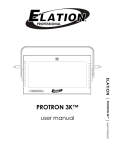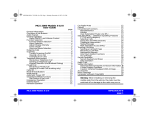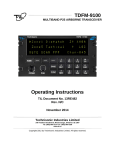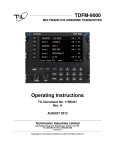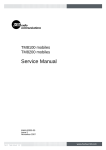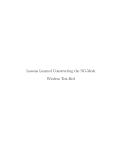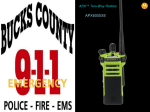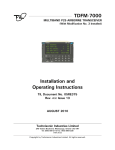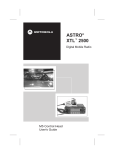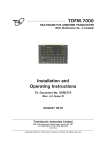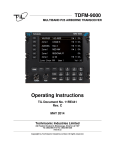Download Motorola MCS2000 Series User guide
Transcript
MCS2000 1-C UG GB (for US) Page 1 Monday, December 8, 1997 3:07 PM MCS 2000 Model I User Guide page General Information . . . . . . . . . . . . . . . . . . . . . . . . . 2 Functions of the Buttons . . . . . . . . . . . . . . . . . . . . . . 2 Audio Signals . . . . . . . . . . . . . . . . . . . . . . . . . . . . . . 3 General operation . . . . . . . . . . . . . . . . . . . . . . . . . . . 4 Radio ON/OFF and Volume Control . . . . . . . . . . 4 Function Selection . . . . . . . . . . . . . . . . . . . . . . . . . . 4 Function Button Selection . . . . . . . . . . . . . . . . . . 4 Menu Selection . . . . . . . . . . . . . . . . . . . . . . . . . . 4 Exiting Functions . . . . . . . . . . . . . . . . . . . . . . . . . 5 Adjust Display Intensity . . . . . . . . . . . . . . . . . . . . 5 Tones On/off . . . . . . . . . . . . . . . . . . . . . . . . . . . . 5 Zone and Mode Selection . . . . . . . . . . . . . . . . . . 5 Outgoing Calls . . . . . . . . . . . . . . . . . . . . . . . . . . . . . 6 Scanning . . . . . . . . . . . . . . . . . . . . . . . . . . . . . . . 6 Turning Scanning On/Off . . . . . . . . . . . . . . . . . . . 6 Viewing a Scan List . . . . . . . . . . . . . . . . . . . . . . . 7 Changing Scan Lists . . . . . . . . . . . . . . . . . . . . . . 7 Telephone Interconnect . . . . . . . . . . . . . . . . . . . . . . 7 Receiving a Telephone Call . . . . . . . . . . . . . . . . . 7 Sending a Telephone Call . . . . . . . . . . . . . . . . . . 8 Keypad Selection (List/Buffered Dialing) . . . . . . . 8 Private Call . . . . . . . . . . . . . . . . . . . . . . . . . . . . . . . . 9 Receiving a Private Call . . . . . . . . . . . . . . . . . . . . 9 Sending a Private Call (trunking only) . . . . . . . . . 9 Enhanced Private Call . . . . . . . . . . . . . . . . . . . . 10 Caller ID . . . . . . . . . . . . . . . . . . . . . . . . . . . . . . . . . . 10 Mode Preset Buttons . . . . . . . . . . . . . . . . . . . . . . . 10 Mode Recall . . . . . . . . . . . . . . . . . . . . . . . . . . . . . . 10 Automatic Power-Off . . . . . . . . . . . . . . . . . . . . . . . 10 SmartZone/AMSS Functions . . . . . . . . . . . . . . . . . 11 Site Search & Site Lock . . . . . . . . . . . . . . . . . . . 11 Emergency Operation . . . . . . . . . . . . . . . . . . . . 11 External Alarm . . . . . . . . . . . . . . . . . . . . . . . . . . 12 MCS 2000 Model I Handset Operation . . . . . . . . . . . . . . . . . . . . . . . . . 12 Car Radio Mute . . . . . . . . . . . . . . . . . . . . . . . . . . . 12 Failsoft . . . . . . . . . . . . . . . . . . . . . . . . . . . . . . . . . . 12 Conventional Operation . . . . . . . . . . . . . . . . . . . . . 13 Repeater/Direct . . . . . . . . . . . . . . . . . . . . . . . . . 13 Monitor . . . . . . . . . . . . . . . . . . . . . . . . . . . . . . . 13 User-Selectable Private Line (PL) . . . . . . . . . . . 13 Stat Alert (MDC - 1200/Star Signalling) Features . 13 PTT ID and Emergency . . . . . . . . . . . . . . . . . . . 13 Selective Calls . . . . . . . . . . . . . . . . . . . . . . . . . . . . 13 Receiving a Selective Call . . . . . . . . . . . . . . . . . 13 Sending a Selective Call . . . . . . . . . . . . . . . . . . 14 Telephone Interconnect . . . . . . . . . . . . . . . . . . 14 Status/Message . . . . . . . . . . . . . . . . . . . . . . . . 14 MDC Repeater Access (RAC) . . . . . . . . . . . . . . 14 Trunking Functions . . . . . . . . . . . . . . . . . . . . . . . . 15 Sending a Call Alert Page . . . . . . . . . . . . . . . . . 15 Receiving a Call Alert . . . . . . . . . . . . . . . . . . . . 15 Reprogram Request . . . . . . . . . . . . . . . . . . . . . 15 One Touch Button Functions . . . . . . . . . . . . . . 15 Out of Range . . . . . . . . . . . . . . . . . . . . . . . . . . . 15 Secure Operation . . . . . . . . . . . . . . . . . . . . . . . . . . 16 Secure Keyload and Erase . . . . . . . . . . . . . . . . 16 Data Operation . . . . . . . . . . . . . . . . . . . . . . . . . . . . 17 Radio Care . . . . . . . . . . . . . . . . . . . . . . . . . . . . . . . 17 Safety Information . . . . . . . . . . . . . . . . . . . . . . . . . 17 Important Electromagnetic Emission Information 18 Control Station Operation . . . . . . . . . . . . . . . . . 18 Caution: VEHICLES EQUIPPED WITH AIR BAGS . 19 Accessories . . . . . . . . . . . . . . . . . . . . . . . . . . . . . . 19 Menu Overview . . . . . . . . . . . . . . . . . . . . . . . . . . . 20 Computer Software Copyrights . . . . . . . . . . . . . . . 20 Warning: When installing or removing the mobile radio from the vehicle, the radio must be switched off or damage to the radio may occur. 68P81083C48-B page 1 MCS2000 1-C UG GB (for US) Page 2 Monday, December 8, 1997 3:07 PM page 2 68P81083C48-B MCS 2000 Model I General Information Functions of the Buttons With the MCS 2000 Model I you have chosen an excellent mobile radio. The Motorola warranty for quality guarantees the high standard of Motorola products. Your MCS 2000 Model I radio has left our factory only after extensive tests. Numbers in brackets refer to the illustrations on the fold out page. Depending on the keypad ordered with your radio, refer to either “E” or “I” for the description of the buttons: (A) Radio ON/OFF and Volume control (B) Three-color indicator Green, flashing: incoming call or Call Alert Page Red, continuous: radio transmits in clear and secure Orange, continuous: system/channel busy or incoming clear call (secure operation). Orange, flashing: incoming secure call (secure operation). (C) Display with symbols and one line of 8 characters. (D) Mode selector (F) Transmit key (PTT) Push to talk, release to listen. (G) Microphone connector (1) Zone select (2) Monitor, press button to listen for activity (conventional operation) or Search (AMSS/SmartZone operation) (3) HOME This user guide describes the way a standard radio works. Since standard operation may be changed by programming - both concerning the Functions which the radio includes and the Buttons used to activate them - the way your radio operates may differ from what is described here. The radio display prompts may be programmed into the radio in one of a number of different languages. English is the default language and is used to describe the displays in this user guide. For further information, contact the person in charge of your radio system or your local service representative. MCS2000 1-C UG GB (for US) Page 3 Monday, December 8, 1997 3:07 PM (4) (5) (6) (7) (8) (9) (10) (11) (12) (13) Secure on/off (secure operation) Emergency External alarm Telephone interconnect or Secure on/off (secure operation) Scan Menu Option Page Private call Select Audio Signals High tone Ringing tone Low tone Phone initiate/Receive Emergency activate Emergency acknowledgement Emergency exit Failsoft (repeated every 10 seconds trunking) Out of range (repeated, trunking) Keypad entry accepted Radio self-test failed/ Key entry not accepted/Time out timer warning/ System reject Call alert acknowledgement Function/Channel/Hardware error, tone continues until valid operation or radio turned off. Busy (repeated four times) Keyfail (secure operation) Automatic call back (trunking) PTT pressed in clear mode (secure operation) Call alert sent Call alert received (repeated every five seconds) Call initiated (Enhanced Private Call) Selective call received (Private Call II) Incoming private call (repeated for 20 seconds) MCS 2000 Model I 68P81083C48-B page 3 MCS2000 1-C UG GB (for US) Page 4 Monday, December 8, 1997 3:07 PM page 4 68P81083C48-B MCS 2000 Model I General operation Function Selection Radio ON/OFF and Volume Control Turn the radio on by pressing the on/off button (A). The radio then carries out a self-test. Adjust the volume to a comfortable listening level by turning the on/off button (A). Functions programmed into the radio can be selected in two different ways: 1 Directly via a pre-programmed, dedicated button, or 2 Indirectly via the radio MENU. Note: If equipped, your radio may be programmed with ignition sense enabled. Depending on programming, if the ignition is turned off, the radio will: • turn off • inhibit transmit capability, or • inhibit the use of the PTT button. Contact your system operator for further information. Turn the radio off by pressing the on/off button (A) again. Note: If the radio sounds the error tone and displays an error message, please contact the person in charge of your radio system or your local service representative. Function Button Selection For direct access to a feature, depress the desired function button. A triangle in the display points to the function button used. If the function requires additional input, use the mode selector (D) to display your choices, and press the select button (13). Note: Function buttons are usually active. Pressing a function button will exit the current feature and start the selected feature. Menu Selection Features may be accessed indirectly through the radio menu. The menu is selected by pressing the menu button (9). Selections are made by using the mode selector (D) to the desired function. Press the select button (13). The radio will leave menu mode and enter the selected feature, or enter a sub-menu. If additional MCS2000 1-C UG GB (for US) Page 5 Monday, December 8, 1997 3:07 PM input is required, use the selector (D) to select the desired function. Press the select button (13). A list of potential menu functions is found in the back of this user guide (page 20). Exiting Functions If your radio is programmed with a HOME button (3), press it to exit any function/menu. If no HOME button is programmed, press the function button once to exit the function. If the function is accessed via the menus, press the menu button (9) twice to exit. Adjust Display Intensity Select the menu INTNSITY as described above. Press the select button (13). The display intensity may then be adjusted to one of four levels: high, medium, low or very low, using the selector (D). Tones On/off The tones heard every time a key is pressed may be turned off or on through the menus. Select the menu TONES as described above. Press the select button (13). The display then shows the present state e.g. MCS 2000 Model I TONE ON Use the mode selector (D) to toggle between “TONE OFF” and “TONE ON”. Press the select button (13) when the desired state is in the display. Zone and Mode Selection A mode is a channel or talkgroup and all its related features. A zone is a grouping of modes that can be selected by pressing the zone button (1). Use the mode selector (D) to display the desired zone e.g. SECURITY The zone name flashes until you press the select button (13) to choose it. Then use the mode selector (D) until the desired talkgroup/channel is displayed, e.g. GROUP 1 68P81083C48-B page 5 MCS2000 1-C UG GB (for US) Page 6 Monday, December 8, 1997 3:07 PM MCS 2000 Model I Outgoing Calls When you have selected zone and mode, you are ready to transmit. Lift the microphone out of its holder and press the transmit key PTT (F) while talking, release it while listening. Speak in a normal tone of voice, keeping a distance of 5 -10 cm (2-4”) from the microphone. While transmitting the red indicator (B) will light. Conventional only: If the orange indicator is lit, the channel is busy. Wait for the indicator to turn off before transmitting. Trunking only: If the busy tone sounds, release the PTT (F) and wait for the automatic call back tone. When this tone is heard, press the PTT (F) within 3 seconds to transmit the call again. If your radio is equipped with a time out timer, a warning tone will sound a few seconds before the call is terminated. Scanning Scan allows the user to monitor more than one channel or talkgroup (including the selected channel or talkgroup) at a time for activity. page 6 68P81083C48-B Channels within a scan list may be assigned priority levels as follows: Priority 1: Most important Priority 2: Second most important Non-Priority: Normal scan list member without priority In scan the radio will listen to the channel/talkgroup with the highest priority. If a channel/talkgroup with a higher priority becomes active while the radio is listening to a lower priority member, the radio will switch to the higher priority channel/talkgroup. Note: If the user is involved in a conversation, he will not be interrupted by any normal priority calls. Turning Scanning On/Off The scanning feature may be turned on via the Scan button (8) or via a menu as previously described. For as long as “SCAN ON” is selected, the scan icon ( ) will be on in the display and the radio will scan for activity in the channels/talkgroups that are defined in the scan lists of the present mode. Note: If a mode is pre-programmed with autoscanning, the radio scans automatically when- MCS2000 1-C UG GB (for US) Page 7 Monday, December 8, 1997 3:07 PM ever this mode is selected and scan cannot be turned off. Viewing a Scan List Select the menu VIEW LST as previously described, then use the mode selector (D) to display the menu SCAN. Press select (13). The dot in the scan icon flashes if the mode is priority 1, lights continuously if the mode is priority 2 or the icon lights continuously to indicate a normal priority mode. The programming icon will be on while the list is viewed. Use the mode selector (D) to view the next member. When all members have been viewed the function should be exited. Changing Scan Lists If a scan list is user programmable, it may be changed by the user (members added or deleted). Select the menu PGM LIST as previously described, then use the mode selector (D) until SCAN is displayed and press the select button (13) or Press and hold the scan button (8) until the key press and accepted tone is heard. The programming icon the triangle in the display flash. MCS 2000 Model I Use the mode selector (D) to select the desired mode. Press the select button (13) if the scan icon is not in the display, to include the mode as a normal priority member. Press the button again to make the mode priority 2 (the scan icon lights continuously). Press the button a third time to make it a priority 1 mode (the dot in the scan icon flashes). Pressing the button again makes the mode non-member (mode not included in the list). Telephone Interconnect Telephone interconnect is used when the radio is required to operate in a radio system connected to a public or private telephone system. Receiving a Telephone Call When your radio receives a telephone call, a telephone ringing tone sounds and the display alternates between PHONE and the home display. The green indicator (B) and the call received icon flash. 68P81083C48-B page 7 MCS2000 1-C UG GB (for US) Page 8 Monday, December 8, 1997 3:07 PM page 8 68P81083C48-B MCS 2000 Model I Press the phone button (7) to answer the call. Exit the function when the conversation is over. Sending a Telephone Call List Selection Press the menu button (9) and use the mode selector (D) until PHONE is displayed. Press the select button (13) and use the mode selector (D) until the desired name or number is displayed. Press the select button (13) or the PTT (F). The radio then transmits the number. Note: If your radio has been so programmed, you can press the phone button for quick access to the telephone interconnect function. Using the mode selector (D), you can scroll between last dialled call and phone number lists. Keypad Selection (List/Buffered Dialing) (with optional keypad microphone) Press the phone button (7) or select the menu PHONE as previously described, then enter the desired number directly from the keypad. If you are placing a call to a local extension number requiring a pause before it, press ✱ # . If an incorrect phone number is entered, the digits may be erased using the mode selector (D) down. Continue using the mode selector (D) down to erase the entire number. When the number is complete, press the select button (13) or the PTT (F) to transmit the call. PLS WAIT will be in the display, while the system is setting up the call. Trunking only: If the PHONE system is busy, the display will show PHN BUSY and your call will be placed when the system is available, unless you exit the function. If phone access is unavailable to your radio, the display shows NO PHONE MCS2000 1-C UG GB (for US) Page 9 Monday, December 8, 1997 3:07 PM Private Call Receiving a Private Call When your radio receives a private call, the incoming private call tone sounds and the display alternates between CALL RCV and the home display. The green indicator (B) and the call received icon flash. Press the call button (12) or select the menu PVT CALL to view the ID of the calling party. If the PTT (F) is pressed within 20 seconds, the call is answered and a private conversation can go ahead. Note: If the call button (12) is not pressed, the call will be initiated as a talkgroup call. Exit the function when the conversation is over. Sending a Private Call (trunking only) Private calls can be selected either from a list or directly via the keypad (with optional keypad microphone). MCS 2000 Model I Note: If your radio has been so programmed, you can press the call button for quick access to the Private Call function. Using the mode selector (D), you can scroll between last received ID, Private Call lists and your own radio ID. Press the call button (12) or select PVT CALL through the menus. The display shows the last ID transmitted or received. List Selection: Transmit to the displayed ID by pressing the PTT (F) or choose another ID from the list by using the mode selector (D). To view the radio's own ID, use the mode selector (D) until the display shows: MY ID: alternating with the radio's ID, e.g.: 741317 68P81083C48-B page 9 MCS2000 1-C UG GB (for US) Page 10 Monday, December 8, 1997 3:07 PM page 10 68P81083C48-B MCS 2000 Model I Keypad Selection: (with optional keypad microphone) Press the call button (12) or select PVT CALL through the menus and enter the desired ID directly from the keypad. Until the ID is completed the last digit may be erased by pressing down the mode selector (D). Continue pressing the mode selector (D) down to erase the entire ID. Then enter the correct ID. When the ID has been selected in one of the two ways described above, the private call may be transmitted to the displayed ID by pressing the PTT (F). Enhanced Private Call If an Enhanced Private Call is not answered within 20 seconds the display changes into NO ANSWR Press the PTT (F) to leave your ID with the called radio so that you will be called back later. The call alert sent tone will sound. Caller ID The radio will momentarily display the ID or alias name of the radio that initiated a call. If an emergency call is received in trunked operation, the radio will alternate the display between the talkgroup, the emergency received display and the ID (or alias name) of the radio that initiated the emergency call. Mode Preset Buttons Mode preset buttons will allow quick access to commonly used modes. Press and hold a mode preset button until a good-key tone is heard to program the button for the currently selected mode. A short press of a mode preset button will cause the radio to immediately change to the mode programmed for that button. Mode Recall The radio will always remember the last mode selected. Pressing mode recall will cause the radio to switch to the previously selected mode. Note: The “last” mode must be selected for a minimum of 5 seconds to be retained as the “last” mode. Automatic Power-Off “Automatic power off” will power off your radio when no user actions occur during a pre-programmed length of time. A user action is defined as the press of a button, turn of a knob or the use of any radio accessory (e.g. footswitch). MCS2000 1-C UG GB (for US) Page 11 Monday, December 8, 1997 3:07 PM 2 minutes prior to automatic power-off, the radio will generate a continuous low tone and PWR OFF will flash on the display. Any user action will immediately cause the radio to cease the automatic poweroff tones and display and return the radio to normal operation. SmartZone/AMSS Functions Press and hold the site search button (2) to force the radio to scan for a new site. If the optional “wide-area roaming” function is programmed the radio will automatically switch sites as it moves through your coverage area. Automatic site switching may be disabled by activating the site lock function. Please contact the person in charge of your radio system for further information. Site Search & Site Lock Emergency Operation If emergency is enabled on your system the function is invoked by pressing the emergency button (5). Emergency is exited by pressing the emergency button for approximately 2 seconds. Press the site search/monitor button (2) to show the current site and signal strength. Additionally a bar display is used to reflect the signal strength level for the current site ranging from 0 to 3 bars: Trunking only: Your radio may be programmed to indicate that an emergency call has been received from another member of your talkgroup. The display will then alternate between In SmartZone and AMSS (Automatic Multiple Site Select) operation the two functions mentioned below may be programmed into your radio: EMER RCV 3 bars indicate a very strong signal and no bar indicates a very weak signal. MCS 2000 Model I and mode name of the calling party. If “emergency with voice to follow” is enabled, the 68P81083C48-B page 11 MCS2000 1-C UG GB (for US) Page 12 Monday, December 8, 1997 3:07 PM page 12 68P81083C48-B MCS 2000 Model I radio will automatically transmit an emergency alarm. It transmits audio through the visor microphone for a pre-defined period of time after pressing the emergency button. Please contact the person in charge of your radio system for further information. Note: Automatic transmit via the visor microphone is possible only with the emergency feature. External Alarm Depending on the accessories ordered and installed with your radio the external alarm function activates the vehicle horn or lights if you do not respond to a call (Page, Trunking Private Call, or Trunking Phone Call) before a pre-programmed time. Press button (6) or select H/L via the menu to turn the external alarm on. “H/L ON” alternates on the display to indicate the feature is active. Turn the alarm off by pressing button (6) again or via the menu. handset speaker and the radio speaker will be muted for privacy. When the handset is placed in the HUB, or when HAND OFF is selected from the menu, audio will be heard through the radio speaker. Car Radio Mute If the car radio mute feature is programmed into your MCS 2000 Model I, your standard car radio will momentarily mute when your MCS 2000 Model I mobile radio is transmitting or receiving. Please contact the person in charge of your radio system for further information. Failsoft The failsoft feature ensures that a conversation is not interrupted if the trunked system fails. In this mode communication will be maintained on an open channel. The failsoft tone will sound every 10 seconds and the display will alternate between Handset Operation To select Handset operation, select HANDSET from the menu and select HAND ON. When HAND ON is selected and the handset is removed from the Hang up box (HUB) audio will be heard only through the FAILSOFT and the current active display. MCS2000 1-C UG GB (for US) Page 13 Monday, December 8, 1997 3:07 PM Conventional Operation Before transmitting, always make sure that the selected mode is free (Orange LED not on). Repeater/Direct Select the menu RPTR/DIR as previously described or press a preprogrammed button. The current mode (direct or repeater) will be displayed. Use the mode selector (D) to toggle the mode. Press the select button (13) to select the displayed mode of operation. Monitor Press the monitor button to toggle monitor on or off. Press and hold the monitor button to enter squelch configuration. Using the mode selector (D), the squelch level of the radio may be fine-tuned. Press the select key when the desired level is attained. User-Selectable Private Line (PL) User Selectable Private Line (PL) allows the radio user to select a PL code from a pre-programmed list of codes. Press the Multiple Privale Line (MPL) button (if programmed) to view the current PL or press and hold the MPL button to enter MPL configuration. Use the mode selector to change the PL code and press the select key when the desired PL is displayed. MCS 2000 Model I Stat Alert (MDC - 1200/Star Signalling) Features PTT ID and Emergency Each radio can be programmed to send a unique digital identification code at the beginning of each transmission, at the end, or both. When the PTT-ID is programmed to come before voice transmission, you will hear a tone until the ID transmission is complete. This ID may be combined with an emergency alarm that is activated by an emergency button on the radio. The dispatcher can quickly identify the radio user in an emergency situation. Emergency Operation Emergency is operated as previously described. Selective Calls Receiving a Selective Call The radio will display CALL RCV for two seconds upon receiving a Selective Call. You can enter Selective Call to view the ID of the calling radio and to respond with a Selective Call (see below). 68P81083C48-B page 13 MCS2000 1-C UG GB (for US) Page 14 Monday, December 8, 1997 3:07 PM page 14 68P81083C48-B MCS 2000 Model I Sending a Selective Call Press the call button (12) or select the menu CALL as previously described. Enter the ID via the keypad or use the mode selector (D) to scroll to the ID you wish to call. Press the PTT (F) to transmit the selective call to this ID. If automatic Selective Call is disabled, the radio exits Selective Call after the transmission. If automatic Selective Call is enabled, the radio will remain in Selective Call until you exit. Call Alert See trunking section for more details. Telephone Interconnect To make a call through the telephone system in the conventional mode your radio must send access and hangup codes to the system. The access code can be transmitted in either of two ways, depending on how your radio is programmed. Immediate: The radio automatically sends a prestored access code as soon as the telephone interconnect button (7) is pressed. Delayed: Press the Select button (13) or the PTT (F) and the radio sends the pre-stored access code. After the access code is sent, you should get a dial tone. (If no dial tone sounds, exit the function to hang up.) Now press the Select button (13) or the PTT (F). The radio then transmits the number. The call is then handled as described under “Sending a Telephone Call” above. Status/Message Select the menu STATUS or MESSAGE as previously described. The last acknowledged status or the first message will be displayed. Use the mode selector (D) to scroll through the lists of possible statuses or messages. When the display shows the desired status or message, press the select key (13) to transmit the status or message. Four beeps will sound to indicate that the status or message has been received. The radio will automatically exit the status/message feature. If the status or message is not received, the radio will display NO ACK and generate a continuous tone. Press the select (13) key to transmit the status or message again or exit the function. MDC Repeater Access (RAC) MDC repeater access will select a repeater for transmission. Consult your system administrator for more information. MCS2000 1-C UG GB (for US) Page 15 Monday, December 8, 1997 3:07 PM Trunking Functions Sending a Call Alert Page Select the menu PAGE as previously described, then use the mode selector (D) to display the desired ID. Press the PTT (F) the select button (13) to send the Call Alert Page. The call alert page acknowledgement tone is heard if the called radio receives the call alert page. If the page is not received the display will show NO ACK Exit the function to return to the home display. Reprogram Request If dynamic regrouping is programmed into your radio, the reprogram request function may be selected through a menu. A reprogram request will send a message to the console operator requesting that the operator assigns the radio to a new talkgroup. See your system administrator for further details. One Touch Button Functions If this optional feature is programmed in your radio, a button may be dedicated to sending a pre-programmed status, message, call alert or dialing a preprogrammed phone number. See your system administrator for further details. Receiving a Call Alert When a call alert is received, the call alert received tone is heard, the green LED and the icon flash in the display until the Call Alert is acknowledged by pressing the PTT (F) or pressing and releasing the monitor button (2). Out of Range If this optional function is programmed into your radio, it will indicate when you have left your radio coverage area. The display will alternate between Status/Message Operated as previously described under Conventional Functions. and the current mode and the out of range tone will sound. MCS 2000 Model I NO SYS 68P81083C48-B page 15 MCS2000 1-C UG GB (for US) Page 16 Monday, December 8, 1997 3:07 PM MCS 2000 Model I Secure Operation Note: This section applies only if secure operation is programmed into your radio. This section lists features where differences occur when operating in secure. For other feature operation see General Operation above. Outgoing Calls: When the selected mode is not preprogrammed as either secure-only or clear-only, secure transmit is turned on/off by pressing the secure button (4), except for trunking telephone interconnect and private call which are always controlled by the button. A beep immediately after the PTT is pressed indicates a clear (non-secure) transmission. Note: If the secure button is pressed during a transmission, the transmission is aborted, and an alert tone will sound until the PTT is released. The operation change will be effective with the next PTT press. Incoming Calls: When a secure call is received the orange LED (conventional only) and the secure icon will flash. page 16 68P81083C48-B Conventional Functions: In monitor, only calls from radios with the same encryption key will be heard. Calls with a different key will be heard as noise. Trunking Functions: When secure transmit is controlled by the secure button (4), during a talk group or private call you can only change from clear to secure operation. During a telephone interconnect or failsoft call you can change from clear to secure operation, or from secure to clear. During an emergency call NO change is possible. Secure Keyload and Erase An encryption key must be loaded from a Key Variable Loader (KVL) that corresponds to the encryption type of the radio. Disconnect the microphone cable from the controlhead and attach the keyloader cable. The display shows “KEYLDNG” (KEYLOADING), and normal transmit and receive is disabled. Refer to the KVL instruction manual for loading procedure. MCS2000 1-C UG GB (for US) Page 17 Monday, December 8, 1997 3:07 PM Note: For some earlier radio models, enter the keyloading mode by pressing and holding the secure button (4) until the display changes showing the secure menu's first item. Scroll to the “KEYLOAD” choice, and press the select button. To exit, press the home button. When the key has been loaded successfully, the radio will sound one long beep. To erase a key, press and hold the secure button (4) until the display changes showing the secure menu's first item “ERASE KY”, and press the select button. When key erase is complete, the display will show “ERASED”. Note: If battery power is removed from the radio for more than 3 days, the radio may lose its encryption key. Data Operation If your radio is programmed for data operation, you may send and / or receive data messages from a data terminal. While sending or receiving data, the radio will display MCS 2000 Model I DATA XFR Any button press will cause the radio to interrupt the data transfer and return the radio to normal operation. Please contact the person in charge of your radio system for further information. Radio Care • • Avoid any physical abuse of the radio. The radio exterior should be cleaned with a cloth dampened with clean water, a mild liquid soap solution or isopropyl alcohol. CAUTION The use of chemicals such as detergents, alcohol (except isopropyl), aerosol sprays, and petroleum products may be harmful and damage the radio housing. Safety Information Every radio, when transmitting, radiates energy into the atmosphere which may, under certain conditions, cause the generation of a spark. All users of vehicles fitted with radios should be aware of the following warnings: 68P81083C48-B page 17 MCS2000 1-C UG GB (for US) Page 18 Monday, December 8, 1997 3:07 PM MCS 2000 Model I Do not operate radio near inflammable liquids or in the vicinity of explosive devices During normal use, the radio will subject you to radio energy substantially below the level where any kind of harm is reported. To ensure personal safety, please observe the following simple rules: • DO NOT transmit when the antenna is very close to, or touching, exposed parts of the body, especially the face and eyes. • DO NOT hold the transmit (PTT) key in when not actually desiring to transmit. • DO NOT allow children to play with any radio equipment containing a transmitter. • DO NOT operate radio while driving. It should also be noticed that the use of a hand held microphone while driving could constitute an offence under the Road Traffic Regulation. Important Electromagnetic Emission Information In August, 1996, The Federal Communications Commission (FCC) adopted an updated safety standard for human exposure to radio frequency electromagnetic energy emitted by FCC regulated equipment. Motorola subscribes to this same updated safety standard for the use of its products. page 18 68P81083C48-B In keeping with sound installation practice and to maximize radiation efficiency, a one-quarter (1/4) wave length antenna should be installed at the center of the vehicle roof. If it is necessary to mount the antenna on the vehicle's trunk lid, an appropriate 3dB gain antenna should be used. This installation procedure will assure that vehicle occupants will be exposed to radio frequency energy levels lower than the limits specified in the standard adopted by the FCC in General Docket 79144. To assure that radio frequency (RF) energy exposure to bystanders external to a vehicle is lower than that recommended by FCC adopted standard, transmit with any mobile radio only when bystanders are at least two (2) feet away from a properly installed externally mounted antenna for radios with less than 50 watts of output power, or three (3) feet away for radios with 50 watts or greater power. Control Station Operation In the event of Control Station operation, to assure operators and bystanders are exposed to radio frequency (RF) energy levels lower than the limits specified in the FCC adopted standard, the antenna should be installed outside of any building, but in no instance shall the antenna be within two feet (less than 50 watts power output) or within three feet (50 watts or MCS2000 1-C UG GB (for US) Page 19 Monday, December 8, 1997 3:07 PM higher power output) of station operators or bystanders. When planning the installation of communication equipment in a vehicle with one or more air bags: Caution: VEHICLES EQUIPPED WITH AIR BAGS • • • An air bag inflates with great force. DO NOT place objects, including communication equipment, in the area over the air bag or in the air bag deployment area. If the communication equipment is improperly installed and the air bag inflates, this could cause serious injury. Installation of vehicle communication equipment should be performed by a professional installer/technician qualified in the requirements for such installations. An air bag’s size, shape and deployment area can vary by vehicle make, model and front compartment configuration (e.g., bench seat vs. bucket seats). Contact the vehicle manufacturer’s corporate headquarters, if necessary, for specific air bag information for the vehicle make, model and front compartment configuration involved in your communication equipment installation. MCS 2000 Model I Accessories Please contact you local Motorola representative for further information about the accessories listed below: Microphone Options: • Palm Microphones • Keypad Microphones • Noise Cancelling Microphones • Visor Microphone • Desk Microphones • Telephone Style Handsets Mounting Accessories: • Tilt Mount Bracket • Key Lock • Direct Trunnion Mount • Base Tray with Loudspeaker • Remote Mount Option A Variety of External Loudspeakers (low/high power) A Variety of Cable kits Desk (Control Station) Accessories: • Power Supplies • External Emergency Foot-switch Antennas 68P81083C48-B page 19 MCS2000 1-C UG GB (for US) Page 20 Monday, December 8, 1997 3:07 PM MCS 2000 Model I Menu Overview Zone: Select a Zone (same as button - 1) Channel: Select a channel (Same as mode selector D) Scan: Scan ON or OFF (Same as button - 8) Tones: Keypad entry tones ON or OFF Display intensity: Adjust display backlight View: View a Scan, Telephone, Private Call, or Call Alert List Program lists: Program a Scan, Telephone, Private Call, or Call Alert List Horn/Lights: Turn External Alarm (Horn/Lights) ON or OFF (Same as button - 6) High/Low power: Set the radio to High or Low Power level(s) Transmit inhibit: Turn the transmitter ON or OFF Private Call: Select Private Call feature. (Same as button - 12) Page: Select the Call Alert Feature. (Same as button - 11) Phone: Select a Phone feature. (Same as button - 7) Status: Select and send a pre-programmed status from a list page 20 68P81083C48-B Message:Select and send a pre-programmed message from a list Handset:Select handset mode of operation Trunking Reprogram Request: Request Dynamic Regrouping program change Wide-Area Trunking Site Lock/Unlock: Disables or enables automatic site switching Conventional Only Repeater or Direct: Enables repeater access or talkaround capability. Computer Software Copyrights The products described in this manual may include copyrighted computer programmes stored in semiconductor memories or other media. Laws in the United States and other countries preserve for Motorola/Europe and Motorola Inc. certain exclusive rights for copyrighted computer programmes, including the right to copy or reproduce in any form the copyrighted computer programme. Accordingly, any copyrighted computer programmes contained in the products described in this manual may not be copied or reproduced in any manner without the express written permission of the holders of the rights. Furthermore, the purchase of these products shall not be deemed to grant either directly or by implication, estoppel, or otherwise, any licence under the copyrights, patents, or patent applications of the holders of the rights, except for the normal non-exclusive royalty free licence to use that arises by operation of law in the sale of the product.




















